While everyone back home in Canada was contemplating their Christmas left-overs this Boxing Day morning, we were contemplating eternity. We took a trip to South Rome's ancient Appian Way to see the early Christian catacombs of San Callisto.
 |
| Via Appia |
This trip to Rome was our first trip overseas as a couple instead of a family. As parents of a sixteen-year-old, we are re-discovering ourselves as a couple and our mutual desire to explore the world. Becoming a duo again had such a "Roman-tic" feel to it, and because of our love for Italy (and especially Rome), this is the place to kick off this new chapter of our lives. Of course, every new journey begins with a road whether it is figurative or literal and our whole trip seemed to involve some kind of road. The first road for us, being Rome's famous Appian Way. Of course, nothing says "romance" like dead things...💑
 |
| Porta S. Giovanni In Aurelian Wall |
The Via Appia, as it is called in Rome, was ancient Rome's main road that ran 430 miles south to the Adriatic port of Brindisi, which was the Romans' port to access to Greece. This was once a bustling superhighway of soldiers and merchants and the most important road of the Republic. Built in the year 312 BCE this road was nicknamed "The Queen of Long Roads" by the Roman people. The Via Appia starts in the Roman Forum and passes through two Ancient city walls: the Servian Wall built at the same time as the Via Appia and the Aurelian Wall constructed a century later. Much of the Via Appia is preserved today as parkland and the original stones of the road are intact.
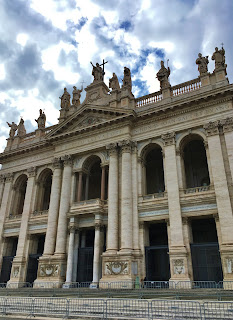 |
| San Giovanni in Laterano |
This is the furthest south we have been in Rome. There are many ancient sights here, but they are quite spread out, and a bus, bike or taxi is a must to go see them. We took a bus to the Archbasilica of St. John Lateran. San Giovanni in Laterano was constructed in 318, about 600 years after the Via Appia, upon the site of an old Roman Fort and part of the Lateran Palace. It is the first church in Rome where Christians could worship legally. This was the Basilica of the Pope; so, therefore, it is an Archbasilica and through medieval times it served as the first Vatican until St. Peter's Archbasilica was built in the 1500s.
We didn't head inside because we were on a mission to go to the catacombs, but I did notice the HUGE ancient bronze doors on the front of the Archbasilica. These bronze doors once hung on the Roman Senate House in the forum-they are well over 2000 years old. Roman recycling at its finest!
Outside San Giovanni in Laterano was this beautiful Egyptian obelisk. It is the tallest standing obelisk in the world! It was initially brought to Rome from the Temple of Amun in Karnak, Egypt and it spent some decades in Alexandria before being placed in the Circus Maximus as a decorative accent. The obelisk was left to ruin with the fall of the Roman Empire in the 4th century and it toppled over, broke into three, and was buried in mud and forgotten for centuries. In the restoration of Rome during the Renaissance, the broken Lateran Obelisk was dug up and restored and in 1588 was erected in the Piazza by San Giovanni. The obelisk replaced the famous statue of Emporer Marcus Aurelius riding a horse that was moved to Piazza del Campidoglio on Capitoline Hill.
 |
| Strolling The Via Appia |
 |
| Citrus Orchard! |
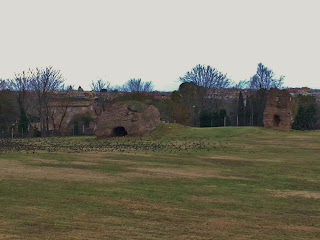 |
| Ruins In Appian Way Park |
At this time of year, there are only birds amongst the meadows, and the silence of the park is somewhat eerie with all history surrounding you. In the summer this park is full of Italians and tourists alike, but on the day after Christmas, this place was a literal ghost town.
The Via Appia fell out of use after the collapse of the Roman Empire, and in the 1700s a new parallel road was built. The original Via Appia from mile 0 to 10 is now protected by this park, and Romans consider it to be "way out in the country" which makes me laugh. Comparing this park to the lively Borghese Gardens in the centre of Rome, I can see what they mean.

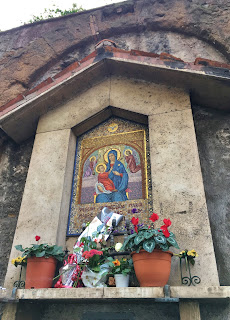 |
| Madonnelle on Via Appia |
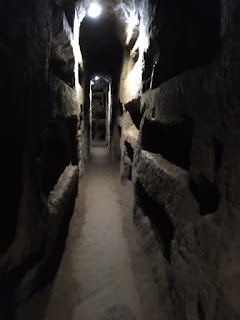 |
| Deep Underground |
We arrived at the site of the catacombs of Saint Callixtus, a massive underground cemetery carved into the tufo stone. The entry fee was €8 per person, and it includes a 30-40 minute tour. The tours are MANDATORY and are offered in many different languages with a very knowledgeable guide. All the catacombs around Rome are owned, preserved and run by the Vatican. TIP#1: You may not stray from the tour route or take any photos once down in the catacombs. This is strictly enforced (I used many pictures from the internet for this article).
Our friend Sara decided to stay behind and grab a coffee in the gift shop which is open year-round, rather than join us for our creepy "tour of things long dead." We met with our English speaking guide who was super informative and very funny. He gave us some background on the catacombs. These particular catacombs date back to the second century and cover over 20 km of pathways, some of which are 5 layers deep, and there are about half a million bodies buried here. TIP #2: It is VERY chilly down in the catacombs wear appropriate clothing. Also, this is a religious site, so your shoulders and knees must be covered in the summer!
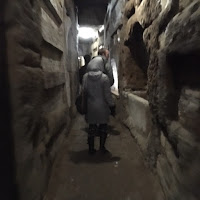 |
| Loculi In The Catacombs |
 |
| The Crypt of The Popes |
There is also a lot of early Christian symbolism on the walls and some of the oldest known Christian frescoes in existence. The frescoes were preserved quite well and really lent to the atmosphere of the catacombs (which were totally creepy.) 👻
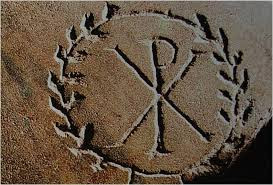 |
| Early Christian Symbols |
One can see a lot of Christian graffiti down there: symbols of fish, anchors, doves, loaves of bread, Phoenix, shepherds and the "Chi Ro" which is the monogram of Christ. It is the Greek first two letters in Christ's name (Christὸs in Greek): X (chi) and P (ro). This is where we get the abbreviation for Christmas being Xmas. Oddly enough, no crosses! The cross and crucifix became a symbol much later in Christianity.
 |
| Santa Cecilia Tomb |
The most evocative crypt is that of the martyr St. Cecilia. In a nutshell: Cecilia was a young and beautiful woman from a noble Christian family who was wedded by her parents to a Pagan man. She converted her new husband to Christianity, then his brother and began to have Christian services in secret at their home in Rome. They were all caught by the authorities, and the two men were executed first, and the young Cecilia was ordered to be steamed alive in her own bathhouse. The soldiers cooked her overnight in her home sauna on the highest heat, but when they opened the door to the bathhouse the next day, she was nowhere near dead. So then they brought her before the governor who ordered her beheaded, and the executioner struck Cecilia with a sword 3 times, which was the maximum allowed by law but he could not sever her head. She lived for three more days in this condition! She was buried in the catacombs of St. Callixtus by Pope Urban and was declared a saint for martyrdom. In 821 remains of St. Cecilia was brought to the Basilica built for her upon her home; St. Cecilia's in Trastevere. The beautiful statue of St. Cecilia in her catacomb niche is a copy of the original sculpture (by Stefano Maderno in 1599) that sits on the tomb of St Cecilia in Her Basilica in Trastevere. Such a moving story to be witnessed at Christmas.

Then with the sun sinking low in the sky, we gathered Sara and headed back to the centre of Rome to the lively Jewish Getto for some red wine to warm up and then on to dinner at our favourite slow food restaurant Grappolo D'Oro in Campo dei Fiore. We ate Cacio è Pepe and talked long into the night about what we had discovered in the Roman catacombs. We conversed so long in fact that a dessert was in order: Tiramisu, which means "pick me up" or "cheer me up."
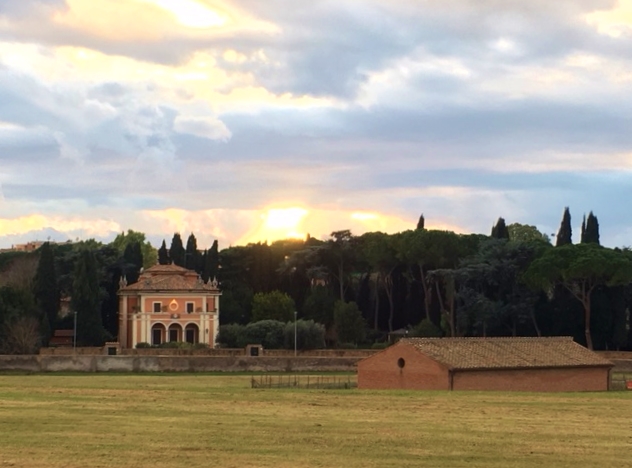
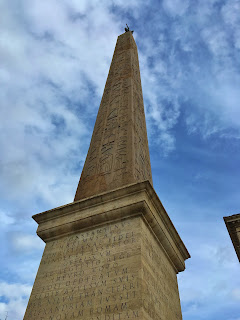

No comments:
Post a Comment